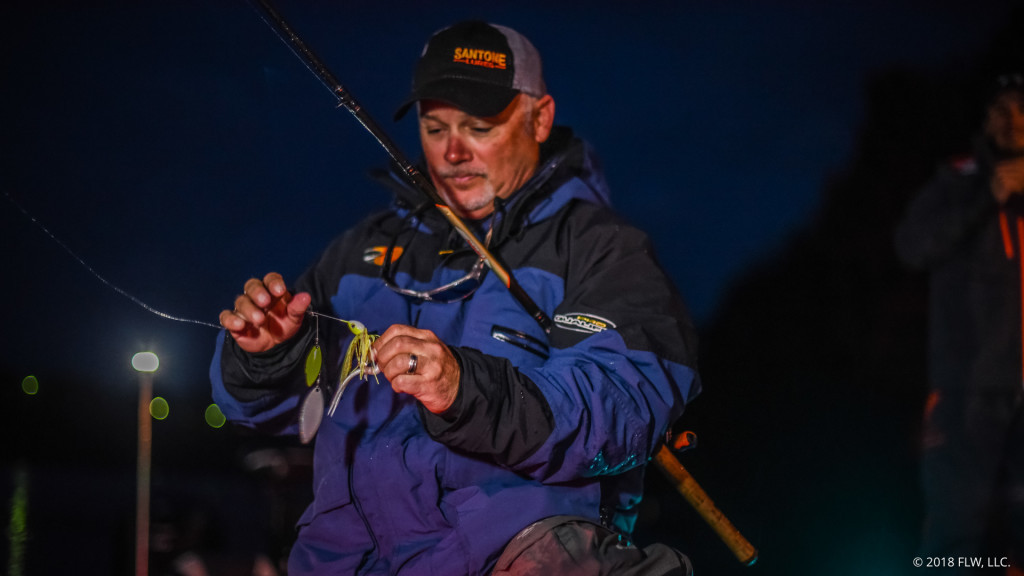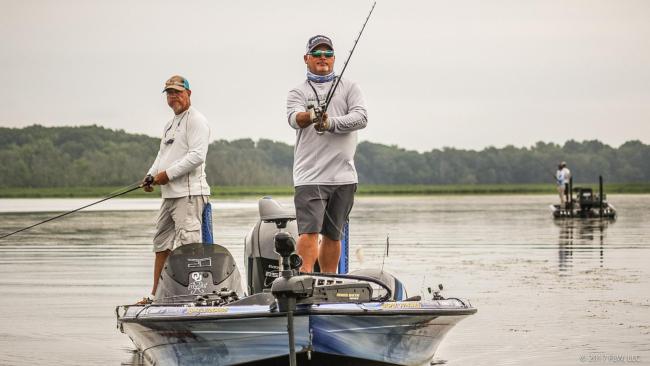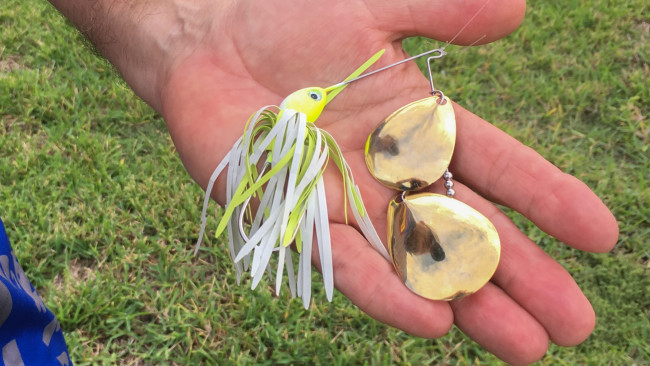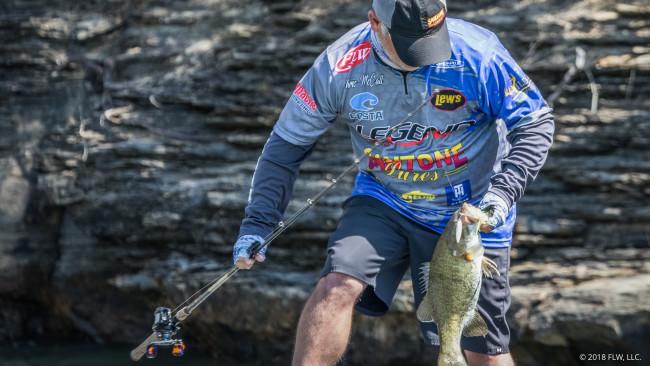Fish Spinnerbaits like McCall this Fall
Three techniques the blade expert leans on when the leaves start turning

For his whole career, Chris McCall has been the kind of angler that likes to keep moving, and a spinnerbait is perfect for that kind of guy. His expertise and passion for a spinnerbait are backed up by results as well. In the last two FLW Tour stops on Lake Cumberland he’s banked two top-10 finishes due at least in part to a blade.
“You can catch fish on it from the dead of winter all the way through the fall,” says McCall of a spinnerbait. “It’s going to catch fish every single month out of the year.”
In the fall, with shad becoming an even more important part of the diet and the water cooling, McCall knows a spinnerbait can shine. These are three of his favorite ways to apply a blade in the autumn months.

1. Run grass edges
Before the grass really starts to die back, McCall likes to cover water with a blade and catch active bass around grass on lakes such as Guntersville, Toledo Bend and Sam Rayburn.
“In the fall, before the grass has fallen over, when it’s still matted up to the top, if you have a day when they aren’t biting a topwater on the edge of the grass you can throw that spinnerbait,” says McCall. “As the grass starts to go to the edge, there will be a little taper or just a wall there, and I like to throw it right along that.”
On a lake he knows well McCall will often run a milk run, but on an unfamiliar fishery he looks for a confluence of good grass and shad – ideally big gizzard shad. He says he’s caught them back in creeks and on the main lake in the fall, so it’s imperative to keep moving in an effort to narrow down a pattern or milk run of spots.
His bait of choice is a 1/2-ounce double-willow Santone M Series Spinnerbait with silver and gold blades and a chartreuse and white skirt. Around the grass he nearly always uses a trailer hook.
2. Target suspended fish on docks
Continuing his effort to target bass keying on shad in the fall, McCall likes to spend time targeting hungry bass suspended around docks. Particularly on lakes such as Lake of the Ozarks, Texoma and Grand Lake, gizzard shad will feed on the algae on the docks, and the bass will follow.
“Sometimes they’ll be on the last docks in the cove where it’s flat,” says McCall. “That’s one place you can always go look in the Ozarks in the fall. But I caught them in the FLW Series tournament on Lake of the Ozarks in 2006, and then you could catch them in the big marinas, out over 30 feet of water.”
Because he can fish a spinnerbait fairly quickly, McCall can thoroughly cover each dock as he dials in a pattern.
“If I’m fishing individual docks, my first cast is always going to be down the front of the dock. I’m going to throw it past the dock, and reel it right down the front. Then, as my boat keeps drifting [from left to right], I’m going to flip down the left-hand side, and then if it’s got a stall I’ll flip both sides of that, and then I’ll end up casting down the right side of the dock. I want to hit every bit of that dock, starting with the front,” says McCall. “There are also times when they’ll get on the backside of the dock and suspend on those poles. You have to figure out where they’re sitting.”
McCall will spinnerbait the backs of docks, but he doesn’t really focus on the bank behind docks with a standard spinnerbait. For that, he’s got other methods (see No. 3). He tries to keep his casts tight to the dock and tries to hit any poles or other parts of the structure.
His dock spinnerbait is often the same 1/2-ounce spinnerbait he throws around grass, but occasionally he’ll go up to a 3/4-ounce model because, especially around deeper docks, the fish won’t always be right up at the surface.

3. Try “hubcapping”
Late in the season in the Ozarks, McCall relishes the opportunity to do some “hubcapping” for big bass. It’s an out-of-the-box spinnerbait pattern that requires some specific conditions and a specific bait, but when it’s on, it’s really on.
Essentially, hubcapping is cranking a 3/8- or 1/2-ounce Santone Pretender Spinnerbait that McCall has specially outfitted with a No. 5 and No. 7 Colorado blade in gold or copper. For added motion with the big Colorado blades, McCall likes an old-school flat rubber skirt. The kicker is that he’s running the bait just below the surface, so it bulges the whole way in.
“The main thing about that spinnerbait is it has to run dead straight,” says McCall. “A lot of times with those big blades, the spinnerbait will want to lay over on its side. That’s the one time I throw a spinnerbait where I’ll go to monofilament a lot of times to help it ride up in the water a little more. You can’t crank it hard, because that gives it a tendency to roll. You get it up, and then it’s a steady retrieve. With those big Colorado’s it’s easy to keep up on the top.”
Hubcapping produces best for McCall on lakes such as Table Rock and Lake of the Ozarks, and the right conditions are paramount.
“It’s usually a big deal later in the fall. I think the water temp has to be 56 degrees or below, and probably the cooler the better,” says McCall. “It’s related to when those fish key on the big gizzard shad. You target the same things you would normally in the fall – wood, channel swings, boat ramps, the bank behind docks. Nasty weather seems to always help it, but once you get those water temperatures right it’s an all-day thing. You may not get but seven or eight bites on it, but they’re going to be big ones.”
McCall says that his best hubcapping finish was 17th back in 2006 in an FLW Series Eastern Division tournament on Lake of the Ozarks, and that his roommate Clark Wendlandt incorporated it in his third-place showing. It’s a unique way to target fish that mostly see a buzzbait or a Plopper-style bait these days, and according to McCall, the bites are pretty electric.

Tackle tweaks
Despite the simplicity of a spinnerbait, there are plenty of tackle adjustments to make depending on the application.
Outside of the blades and the weight, one of the biggest adjustments you can make on a spinnerbait is the hook and trailer hook. When McCall isn’t using a trailer hook, he always goes with a Santone Pretender Spinnerbait, which has a longer, larger hook. For him, it’s a way to run a more snagless bait that still hooks fish very well. When he is running a trailer hook, the Santone M Series Spinnerbait gets the call because its main hook is a little smaller.
McCall nearly always runs a No. 3 or 3 1/2 silver willow and a No. 5 or 5 1/2 gold blade for his standard spinnerbait. In the fall, he’ll sometimes drop down in size, especially if the shad are very small. Typically, just a standard chartreuse/white is his go-to, but in very clear water, blue shad or just white will get the call.
When actually presenting the bait, McCall goes pretty standard. He likes a 6.4:1 Lew’s BB-1 Speed Spool for the majority of his fishing when the water isn’t really cold, and he nearly always uses 15- or 20-pound-test flouro. His rod choice is a little more non-standard.
“With a spinnerbait rod, I don’t want to throw what most companies design for a spinnerbait,” says McCall, who nonetheless uses a medium-heavy Lew’s. “They don’t have enough backbone to them. I want a rod that’s got a little bit of tip and a good backbone. There’s no use in me throwing a 1/2-ounce spinnerbait on a rod that a 3-pounder can kick my butt on. I want to control the fish and get him into the boat in seven seconds instead of 15 seconds.”
McCall is an absolute master with a spinnerbait, and over the years he’s likely won more money on a blade than the average angler will ever win on their whole tackle box. If you’re thinking about getting out on the water this fall, or just want to be better with a spinnerbait, you’d be well-advised to pick up a few of his tips.